- How to Create a 30-60-90-Day Plan?
- Implementing the 30-60-90 Day Plan: Strategies and Tips
- Templates and Examples for a 30-60-90-Day Plan
- Review and Evaluation: Measuring Success in the Plan
- Benefits of a 30-60-90-Day Plan
- 30-60-90-Day Plan: Know When to Implement
- Frequently Asked Questions
30-60-90 Day Plan: A Complete Guide To Mastering This Strategic Roadmap (With Samples)
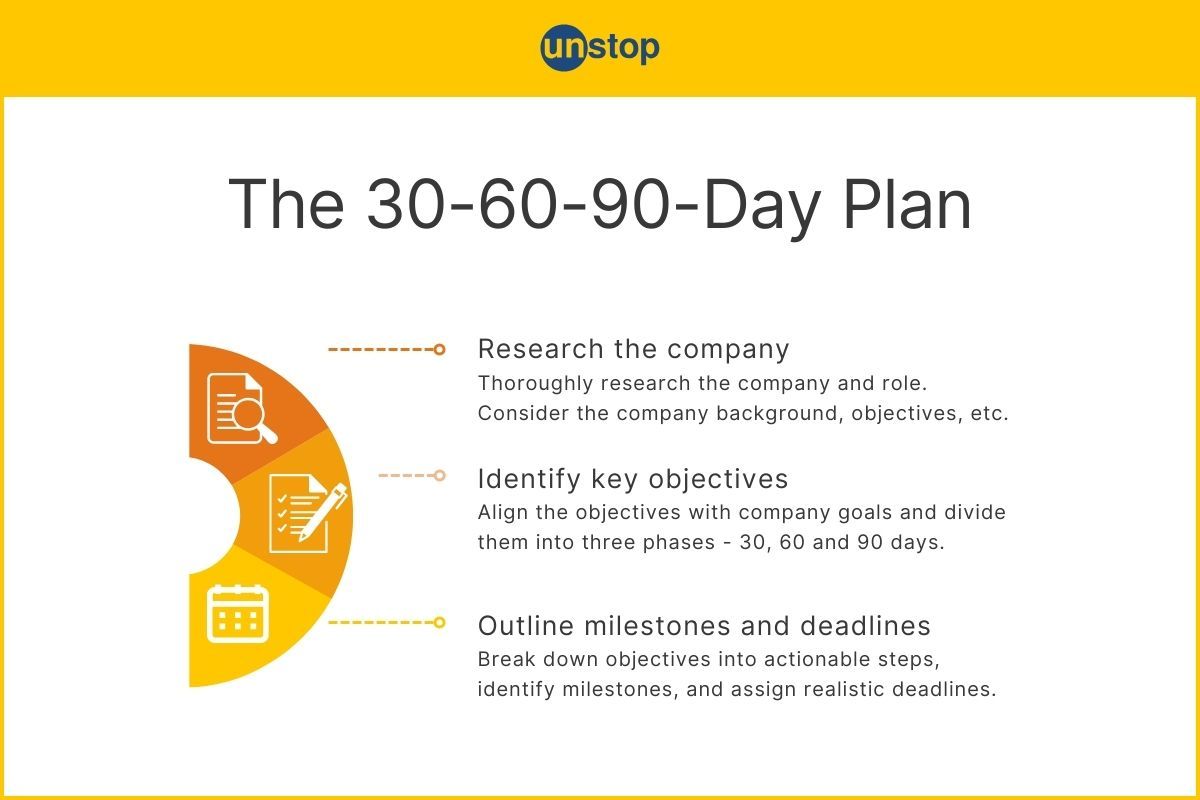
The first three months in a new role can be both exciting and overwhelming. To ensure a smooth transition and set yourself up for success, having a well-structured plan is crucial. This is where the 30-60 90-day plan comes into play.
A 30-60-90 day plan is a strategic roadmap that outlines your goals and objectives for the first three months in a new job. It helps new hires establish clear goals and expectations, navigate the learning curve, and make meaningful contributions from day one. By breaking down the onboarding period into distinct phases of 30 days each, this approach ensures progressive growth and continuous improvement.
Throughout this blog, we will dive deeper into what exactly a 30-60 90-day plan entails, how it can benefit you in your new role, and provide practical tips for creating an effective plan that aligns with your specific objectives.
How to Create a 30-60-90-Day Plan?
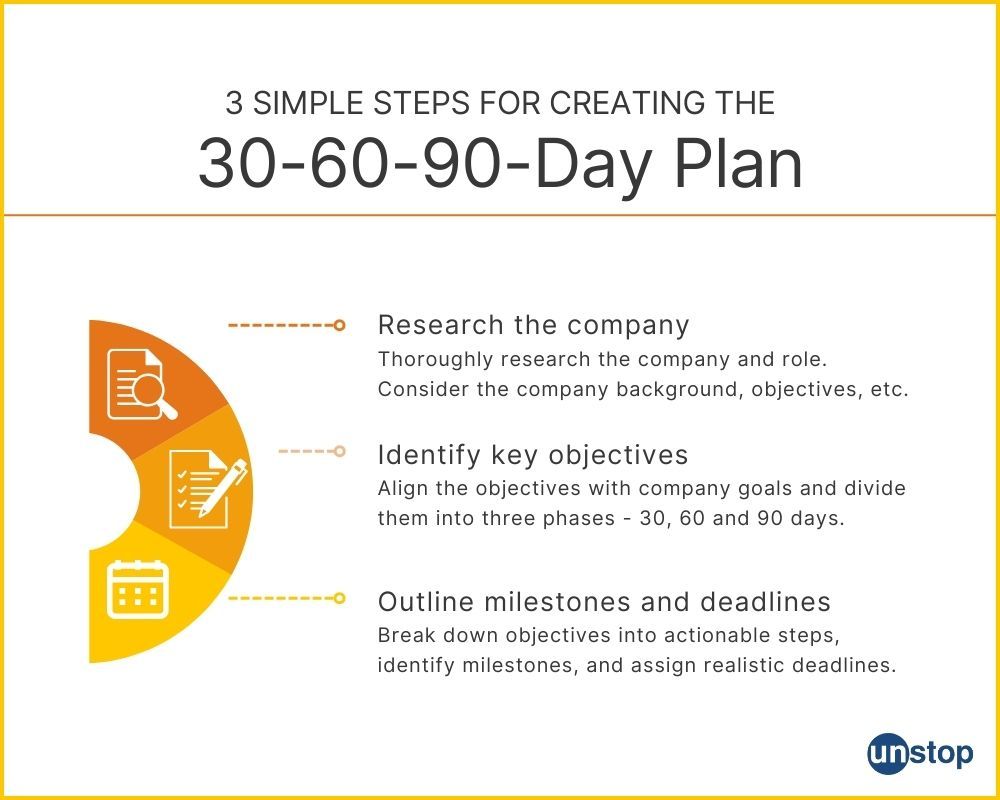
Creating a 30-60-90 day plan is an essential step when starting a new job or taking on a new role. It helps you set clear objectives and outline specific actions to achieve them. Here's a step-by-step guide on how to create an effective 30-60-90 day plan:
Start with Thorough Research about the Company and Role
Before diving into creating your 30-60-90-day plan, it's crucial to conduct a thorough research about the company and the role you will be stepping into. This research will give you valuable insights into the organization's culture, values, goals, and expectations. It will also help you understand the specific requirements of your role and identify key areas where you can make an impact.
Some important aspects to consider during your research include:
-
Company Background: Familiarize yourself with the company's history, mission statement, products or services, target audience, and competitors.
-
Organizational Structure: Understand how different departments or teams are structured within the company and how they collaborate.
-
Job Description: Carefully review your job description to identify the main responsibilities and skills required for your role.
-
Goals and Objectives: Gain clarity on the company's short-term and long-term goals as well as any specific objectives related to your position.
Identify Key Objectives for Each Phase of the Plan
Once you have gathered sufficient information about the company and role, it's time to determine the key objectives for each phase of your 30-60-90 day plan. These objectives should align with both the company's goals and your own professional growth.
Break down your plan into three distinct phases:
-
The First 30 Days: During this initial phase, focus on learning about the company culture, building relationships with colleagues, understanding processes and procedures, and getting up-to-speed with any training or onboarding programs.
-
The Next 30 Days (60 Days): In the second phase, start taking on more responsibilities, contributing to projects, and actively seeking feedback from your manager and team members. This is a critical period for building credibility and demonstrating your value to the organization.
-
The Final 30 Days (90 Days): By this point, you should be fully integrated into your role and the company. Use this time to take ownership of projects, propose new ideas or improvements, and establish yourself as a reliable and valuable team member.
Outline Specific Actions, Milestones, and Deadlines
With clear objectives in mind for each phase of your 30-60-90 day plan, it's important to outline specific actions, milestones, and deadlines that will help you achieve those objectives.
-
Action Steps: Break down each objective into actionable steps that will move you closer to achieving them. These steps should be specific, measurable, achievable, relevant, and time-bound (SMART).
-
Milestones: Identify key milestones or checkpoints along the way that will allow you to assess your progress. These milestones can serve as indicators of whether you are on track or if adjustments need to be made.
-
Deadlines: Assign realistic deadlines for completing each action step or milestone. This will help you stay focused and accountable throughout the process.
Remember that flexibility is also important during this planning process. As you gain more insights into your role and the company dynamics during the initial weeks, be open to adjusting your plan accordingly.
Creating a well-thought-out 30-60-90 day plan demonstrates initiative, dedication, and strategic thinking - qualities that employers value in their employees. By starting with thorough research about the company and role, identifying key objectives for each phase of the plan, and outlining specific actions with milestones and deadlines - you'll set yourself up for success in your new position.

Implementing the 30-60-90 Day Plan: Strategies and Tips
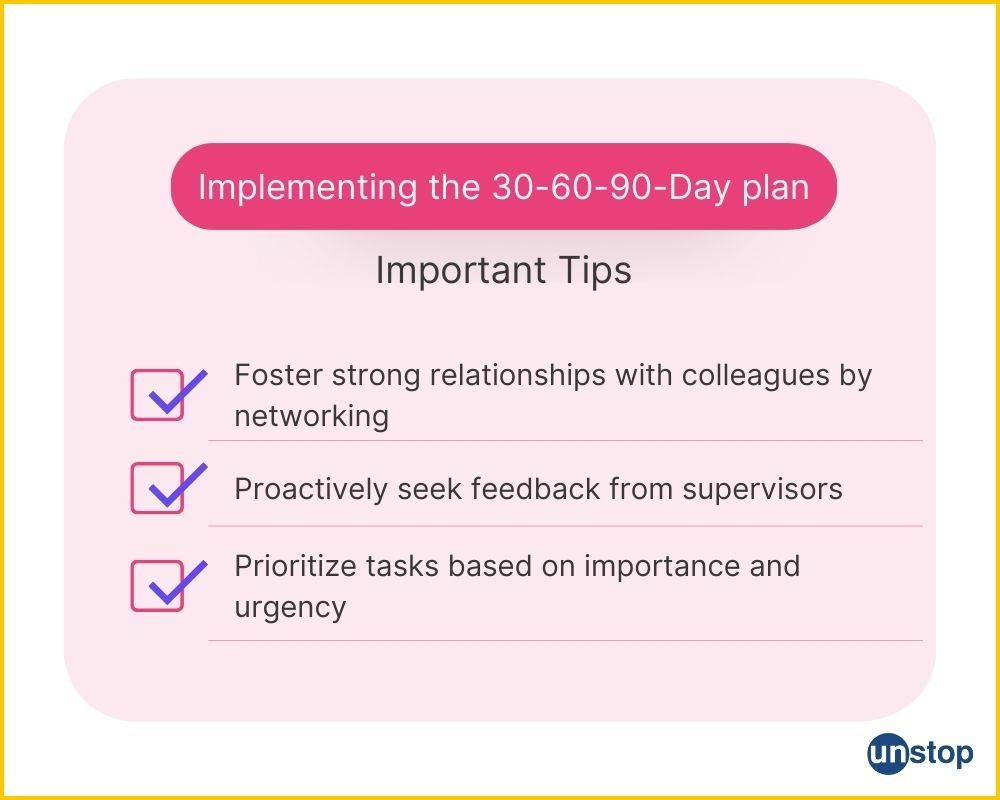
Once you have created your 30-60-90 day plan, it's time to put it into action. Here are some strategies and tips to help you navigate the first few months:
Foster Strong Relationships with Colleagues through Networking
Building strong relationships with your colleagues is essential for a smooth transition into a new position. Actively engage in networking opportunities within your organization to connect with coworkers from different departments or teams.
-
Attend team-building activities or social events to get to know your colleagues on a personal level.
-
Seek out mentors who can provide guidance and support as you settle into your new role.
-
Offer assistance and collaborate on projects whenever possible to establish yourself as a reliable team player.
By fostering these relationships, you'll create a supportive network that can help you navigate internal processes and achieve your goals.
Proactively Seek Feedback from Supervisors
To ensure that you're on the right track and meeting expectations, proactively seek feedback from your supervisors. Don't wait for formal performance reviews; instead, actively request input throughout the 30-60-90 day period.
-
Schedule regular check-ins with your supervisor to discuss progress and address any concerns.
-
Ask for specific feedback on areas where you can improve or excel.
-
Actively listen to their feedback and take constructive criticism positively.
By seeking feedback early on, you demonstrate your commitment to growth and development while also showing that you value their guidance.
Prioritize Tasks Based on Importance and Urgency
As you dive into your new role, it's important to prioritize tasks effectively. Identify which tasks are most critical for achieving short-term success while keeping long-term goals in mind.
-
Assess each task's importance by considering its impact on key objectives.
-
Evaluate urgency by determining deadlines or dependencies associated with each task.
-
Create a prioritized to-do list or use project management tools to stay organized.
By prioritizing tasks strategically, you can ensure that you're making progress on key initiatives and meeting expectations within the designated time frames.
Implementing a 30-60-90 day plan helps you establish clear goals, provides structure, and sets you up for success.
Templates and Examples for a 30-60-90-Day Plan
Creating a 30-60-90-day plan can be overwhelming, especially if you're unsure where to start. Luckily, there are templates available that can provide structure and guidance for crafting your personalized 30-60-90-day plan. These templates serve as a starting point, allowing you to focus on the content rather than the format
A 30-60-90-day plan typically includes the following information:
-
Introduction: This includes the individual’s name, designation, and dates of the plan.
-
Goals and Objectives: Next, outline your goals and objectives for the 30, 60, and 90 days on the job.
-
Key Deliverables: List the specific deliverables or outcomes you aim to achieve at each stage of the plan. This could include things like completing a training program, presenting a project proposal, or achieving certain performance metrics.
-
Action Steps: Break down each goal or objective into actionable steps or tasks. This will help you stay organized and track your progress throughout the plan.
-
Timeline: Include a timeline or schedule for when you plan to complete each action step or task. This will help you stay on track and ensure you are meeting your goals within the designated timeframes.
-
Resources: Identify any resources or support you may need to successfully execute your plan. This could include access to certain tools or software, additional training or mentoring, or collaboration with specific team members.
-
Evaluation: Outline how you plan to evaluate your progress and measure the success of your plan. This could involve regular check-ins with your manager or team, self-assessment, or feedback from colleagues.
Here’s a template for creating a 30-60-90-day plan:
Introduction: Add name, designation and duration
The 30-Day plan: Goals and Action steps
The 60-Day plan: Goals and Action steps
The 90-Day plan: Goals and Action steps
Remember, this is a generic template and can be customized to fit your specific role, industry, and company.
Sample 30-60-90-Day Plan for an Area Sales Manager
Plan for: Add name
Designation: Add job title
Duration: Add start and end date of the plan30-Day Plan:
Familiarize yourself with the company's products, services, and target market.
Meet with your team members individually to understand their roles, responsibilities, and challenges.
Shadow experienced representatives to learn about the sales process and customer interactions.
Analyze current data and identify areas for improvement.
Develop relationships with key clients and prospects to understand their needs and preferences.
60-Day Plan:
Develop a comprehensive sales strategy for your assigned area, including target goals and action plans.
Implement new sales techniques and approaches based on your observations and market research.
Conduct regular team meetings to provide updates, address challenges, and motivate your team.
Collaborate with the marketing department to create effective promotional materials and campaigns.
Monitor sales performance and provide coaching and feedback to team members to drive improvement.
90-Day Plan:
Evaluate the effectiveness of your sales strategy and make necessary adjustments to achieve desired results.
Develop and implement a training program for new representatives to ensure a smooth onboarding process.
Identify potential cross-selling or upselling opportunities to maximize revenue generation.
Build strong relationships with key stakeholders, such as distributors, retailers, and industry influencers.
Prepare a comprehensive report highlighting your achievements, challenges, and recommendations for the future.
Sample 30-60-90-Day Plan for a Content Editor
Plan for: Add name
Designation: Add job title
Duration: Add start and end date of the plan30-Day Plan:
Familiarize yourself with the company's content guidelines, style, and tone.
Review and understand the target audience and their preferences.
Meet with the editorial team to understand their roles, responsibilities, and ongoing projects.
Analyze the current content strategy and identify areas for improvement.
Research industry trends and competitors to stay updated and informed.
60-Day Plan:
Develop a comprehensive content strategy aligned with the company's goals and objectives.
Create a content calendar outlining topics, deadlines, and distribution channels.
Collaborate with writers, designers, and other stakeholders to develop engaging and informative content.
Conduct regular team meetings to brainstorm ideas, provide feedback, and ensure content quality.
Implement SEO best practices to optimize content for search engines and increase organic traffic.
90-Day Plan:
Evaluate the performance of the content strategy and make necessary adjustments based on analytics and audience feedback.
Develop and implement a content promotion plan to increase visibility and reach.
Identify opportunities for guest blogging or collaboration with industry influencers to expand the content reach.
Monitor content performance metrics and provide recommendations for improvement.
Prepare a comprehensive report highlighting the achievements, challenges, and future recommendations for the content strategy.
Review and Evaluation: Measuring Success in the Plan
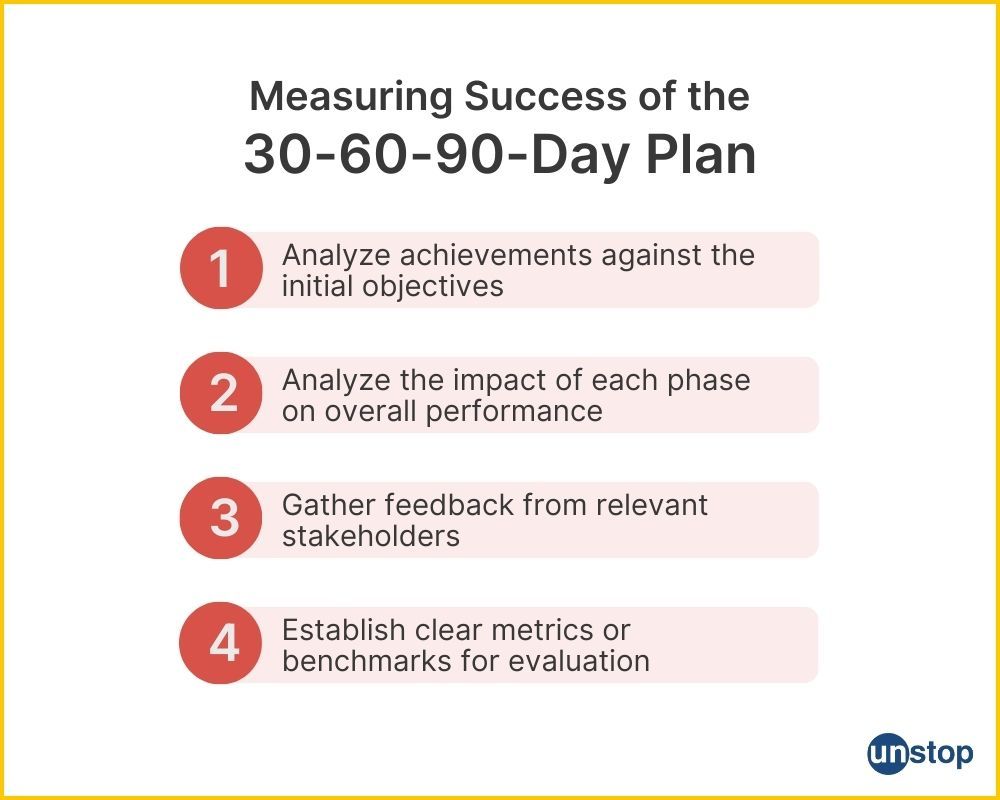
To ensure the effectiveness of a 30-60-90 day plan, it is crucial to regularly assess progress towards set goals. This review and evaluation process allows individuals to analyze their achievements against the initial objectives outlined in their action plan. By doing so, they can identify areas of improvement and make necessary adjustments to enhance performance.
One of the key aspects of reviewing a 30-60-90 day plan is analyzing achievements against the initial objectives. This involves taking a closer look at the goals that were set at the beginning of each phase and evaluating whether they have been met or exceeded. By comparing actual outcomes with expected results, individuals can gain valuable insights into their performance and determine if any modifications need to be made moving forward.
In addition to assessing achievements, it is important to analyze the impact that each phase of the plan has had on overall performance. This perspective allows individuals to understand how their efforts in different areas have contributed to the success or shortcomings of their 30-60-90-day action plan. By examining these details, they can gain a comprehensive overview of their strategy's effectiveness and identify opportunities for improvement.
During this review process, it is also essential for individuals to gather feedback from relevant stakeholders such as team members, managers, or even executive teams. This feedback provides valuable insights into how others perceive their performance and can highlight areas where further development may be needed. By incorporating different perspectives into the evaluation process, individuals can gain a more holistic understanding of their strengths and weaknesses.
To measure success in a 30-60-90 day plan effectively, it is crucial to establish clear metrics or benchmarks for evaluation. These metrics could include specific targets related to sales figures, customer satisfaction ratings, project completion rates, or any other relevant key performance indicators (KPIs). Regularly tracking these metrics throughout each phase ensures that progress can be quantified objectively.
Once an individual has gathered all relevant data and feedback, they can make informed decisions about the necessary adjustments to improve their performance. This may involve revisiting certain strategies, refining goals, or reallocating resources to areas that require more attention. By being proactive in making these adjustments, individuals can ensure that their 30-60-90-day plan remains aligned with their objectives and continues to drive success.
Benefits of a 30-60-90-Day Plan
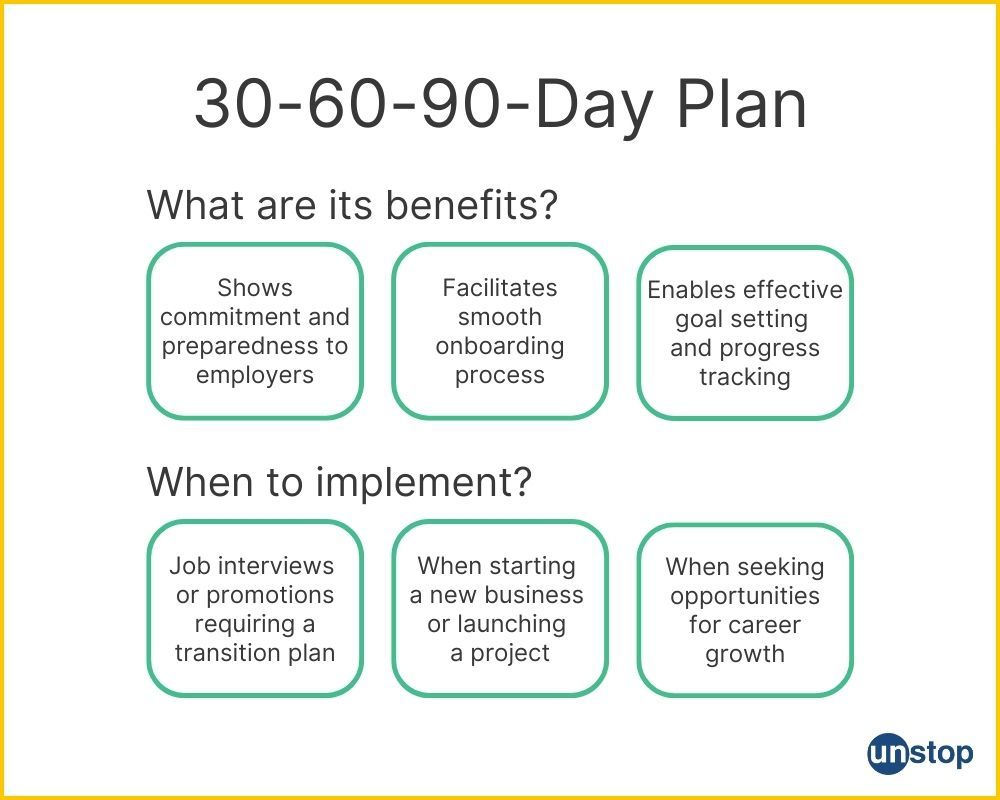
Studies indicate that new employees who go through a structured onboarding program are 58% more likely to be with the organization after three years. Thus, a 30-60-90-day plan is beneficial for both employees and employers. Here are the main benefits:
Demonstrates Commitment and Preparedness to Employers
Having a well-thought-out 30-60-90-day plan shows potential employers that you are serious about the position and have taken the time to understand their needs. It demonstrates your commitment to making an impact from day one. By presenting this plan during an interview or onboarding process, you can showcase your proactive approach and willingness to go above and beyond expectations.
Facilitates Smooth Onboarding Process
Starting a new job can be overwhelming, but having a 30-60-90-day plan can help ease the transition. It provides structure and clarity by outlining what needs to be accomplished within specific timeframes. This not only helps you stay organized but also ensures that you are aligned with your manager's expectations.
Enables Effective Goal Setting and Progress Tracking
A 30-60-90 day plan serves as a roadmap for setting goals and tracking progress throughout your initial months in a new role. It ensures that you are focused on achieving specific objectives while providing a framework for ongoing evaluation.
30-60-90-Day Plan: Know When to Implement
Ideal for Job Interviews or Promotions Requiring Transition Planning
A 30-60 90-day plan can be incredibly beneficial when you are preparing for a job interview or seeking an internal promotion that requires transition planning. This plan allows you to showcase your strategic thinking, organizational skills, and commitment to success. By presenting a well-thought-out plan, you demonstrate your ability to hit the ground running and make a positive impact from day one.
For example, imagine you are interviewing for a managerial position in a company. Creating a 30-60 90-day plan will enable you to outline specific objectives for each phase of your onboarding process. You can include tasks such as learning about the team dynamics, analyzing current processes, identifying areas for improvement, and implementing strategies to drive growth. By presenting this plan during the interview, you not only impress the hiring manager with your proactive approach but also provide them with tangible evidence of how you would contribute to the company's success.
Helpful When Starting a New Business or Launching a Project
Whether you are starting your own business or launching a new project within an existing organization, a 30-60 90-day plan can serve as an invaluable tool. It helps you lay out clear goals and milestones while providing structure and direction during the crucial early stages.
Suppose you're an entrepreneur looking to secure funding for your startup. Developing a comprehensive 30-60 90-day plan will allow potential investors to see your vision and understand how their support will contribute to its success. You could include information on market research, product development strategies, marketing initiatives, and financial projections. By showcasing your strategic thinking and commitment to success, you increase your chances of securing the necessary funding.
Suitable When Seeking Career Growth Opportunities
If you're looking to advance in your career or explore new growth opportunities within your current organization, a 30-60-90-day plan can be a game-changer. It demonstrates your ambition, dedication, and ability to take on more significant responsibilities.
For instance, let's say you've been working as a project manager for several years and aspire to move into a senior leadership role. Creating a 30-60 90-day plan will allow you to outline how you would transition into this new position smoothly. You can include objectives such as building relationships with key stakeholders, developing leadership skills through training programs or mentorship opportunities, and implementing strategies to drive team performance. Presenting this plan to your superiors demonstrates that you are ready for the challenge and have a concrete roadmap for success.
Whether you're starting a new job or embarking on a new project, creating a well-thought-out 30-60-90-day structure can set you up for success. Remember to tailor your plan according to your specific goals and circumstances.
Frequently Asked Questions
1. What industries benefit from using a 30-60-90 day plan?
The 30-60-90 day plan can be beneficial in various industries such as sales, marketing, management consulting, project management, healthcare administration, retail operations, and many more. It provides structure and clarity for professionals entering new roles or taking on significant projects.
2. How long should each section of the 30-60-90-day plan be?
There is no fixed length for each section of the 30-60-90-day plan. However, it is recommended to allocate approximately 30% of your time towards learning during the first month (the "30" part), followed by gradually increasing focus on executing tasks during the second (the "60" part) and third months (the "90" part). Adapt these proportions based on your specific situation.
3. Can I modify my 30-60-90-day plan as I go along?
Absolutely! Your plan should be flexible and adaptable. As you gain more insights and experience, it's natural to make adjustments. Regularly review your plan, assess your progress, and make necessary modifications to ensure it remains aligned with your goals.
4. Is a 30-60-90 day plan only for new employees?
While the 30-60-90 day plan is commonly used by new employees to establish themselves in a role, it can also be valuable for existing employees taking on new responsibilities or projects. The framework provides structure and direction regardless of whether you're starting fresh or transitioning within an organization.
5. How can I measure the success of my 30-60-90 day plan?
To measure success, set specific goals and key performance indicators (KPIs) for each phase. Regularly track your progress against these metrics and evaluate whether you're meeting or exceeding expectations. Adjustments can then be made based on the outcomes observed.
You might also be interested in reading:
- "Where Do You See Yourself In 5 Years?" Now Answer The Most Common Yet Challenging Interview Question
- How to respond to “Tell me about yourself” in a job interview?
- How To Answer "Why Should We Hire You?" (Sample Answers Included)
- Everybody's beloved marketing concept: 4 P's of Marketing
- The art of marketing that a humanities student can master
I’m a reader first and a writer second, constantly diving into the world of content. If I’m not writing or reading, I like watching movies and dreaming of a life by the beach.
Login to continue reading
And access exclusive content, personalized recommendations, and career-boosting opportunities.
Subscribe
to our newsletter
















Comments
Add comment